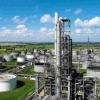I am in the process of reviewing a set of relief calculations that were done for a project put on hold over a year ago that is now active again. The sizing calcs were done for fire case in a series of different size vessels with all the PSV's discharging in to a common header. When I repeated some of the calculations using API 521 methods, I was coming up with significantly different relief loads. Upon further investigation, I found that the original calculations were done using heat input values calculated based on NFPA 30 (2008 Edition). For values of wetted surface area up 200 square feet, the two methods are pretty close, but once WSA exceeds 200 square feet, they are significantly different - with NFPA 30 giving much higher relief rates (approximately double in some cases). Is the use of NFPA 30 appropriate for the case of ASME pressure vessels in a process area? It gives much more conservative sizing, but it also results in a much larger discharge header and relief devices.
Unfortunately, the original design was done by an engineering firm that employed a process engineer on a contract basis, and he cannot be located - otherwise I would be asking him this question!!
Any help from the pro's would be much appreciated!
Best Regards.
|
|
Nfpa 30 Vs. Api 521 Fire Case Heat Input
Started by uiucche94, Jun 15 2009 10:43 AM
3 replies to this topic
Share this topic:
#1

Posted 15 June 2009 - 10:43 AM
#2

Posted 15 June 2009 - 11:16 AM
NFPA 30 is used for low pressure storage tanks, not for pressure vessels. See also http://www.chemcad.c...oads/MNL036.pdf , pages 13 and 14 and Appendix IV. Note that there are more differences between NFPA 30, API 2000 and API 521, for example in how to calculate the wetted area. Personally I would not be worried by using the equations from API Std 521.
#3

Posted 15 June 2009 - 08:04 PM
yes of course.
the first step what you must confirmed is the design pressure of tank/vessel.
cause different case of design pressure of tank will take a different calculation.
Btw2, in my opinion, in both case for wetted area calculation must be the same.
for example 25/30 feet above the ground.
the first step what you must confirmed is the design pressure of tank/vessel.
cause different case of design pressure of tank will take a different calculation.
Btw2, in my opinion, in both case for wetted area calculation must be the same.
for example 25/30 feet above the ground.
#4

Posted 16 June 2009 - 04:35 PM
QUOTE (gvdlans @ Jun 15 2009, 11:16 AM) <{POST_SNAPBACK}>
NFPA 30 is used for low pressure storage tanks, not for process vessels. See also http://www.chemcad.c...oads/MNL036.pdf , pages 13 and 14 and Appendix IV. Note that there are more differences between NFPA 30, API 2000 and API 521, for example in how to calculate the wetted area. Personally I would not be worried by using the equations from API Std 521.
Agreed.
Similar Topics
Steam Pressure In Heat ExchangerStarted by Guest_mvanrijnbach_* , 15 Apr 2025 |
|

|
||
Hysys Expander/compressor Input Using Dimensionless CurveStarted by Guest_Alfreedo_* , 21 Apr 2025 |
|

|
||
Heat Exchanger Steam FlowStarted by Guest_aliebrahem17_* , 25 Nov 2024 |
|

|
||
Discussion - Predict Storage Tank Heat Transfer Precisely By Jimmy D KStarted by Guest_raj shekhar_* , 25 Mar 2025 |
|

|
||
Cross Over Temperature In Countercurrent Heat ExchangerStarted by Guest_panoska_* , 18 Feb 2025 |
|

|

 FB
FB








